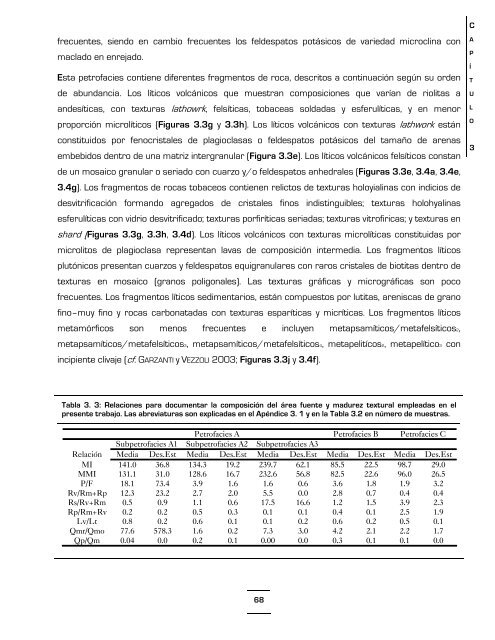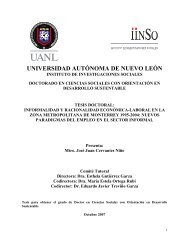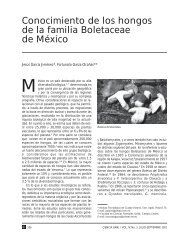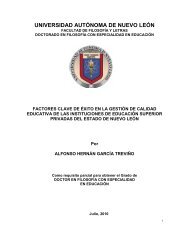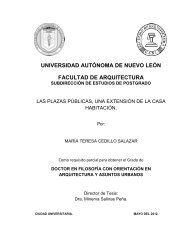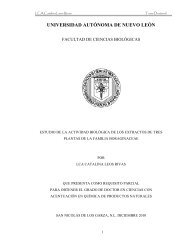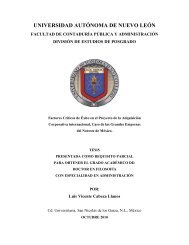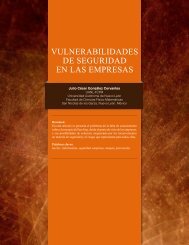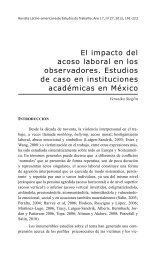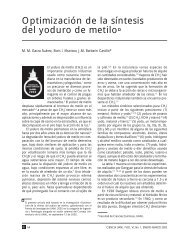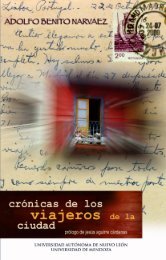- Page 1 and 2:
UNIVERSIDAD AUTÓNOMA DE NUEVO LEÓ
- Page 3 and 4:
UANL UNIVERSIDAD AUTÓNOMA DE NUEVO
- Page 5 and 6:
En Memoria de Elpidea Ocampo Casta
- Page 7 and 8:
Agradecimientos Al pueblo de Méxic
- Page 9 and 10:
2.3.5.1 Facies Lg: Lag= Concentraci
- Page 11 and 12:
7.5 SEDIMENTOLOGÍA 156 7.6 EVIDENC
- Page 13 and 14:
FIG.2. 15: REPRESENTACIÓN GRAFICA
- Page 15 and 16:
FIG. 3. 18: DIAGRAMA BINARIO QUE CO
- Page 17 and 18:
FIG. 6. 14: DIAGRAMA DE FUNCIONES D
- Page 19 and 20:
Índice de Tablas TABLA 3. 1: PARÁ
- Page 21 and 22:
Abstract Mesozoic sedimentary seque
- Page 23 and 24:
El Noreste de México se encuentra
- Page 25 and 26:
El presente trabajo, por medio de a
- Page 27 and 28:
Durante las décadas de los 70s−8
- Page 29 and 30:
Terreno Sierra Madre muestra un bas
- Page 31 and 32:
unidades 2 y 3 de la Formación La
- Page 33 and 34:
102° W 26° N 25° N 102° W Falla
- Page 35 and 36:
Los estratos de arenisca son de gra
- Page 37 and 38: Miembro Arenoso Galeana como un com
- Page 39 and 40: 2 ANÁLISIS DE FACIES, ASOCIACIONES
- Page 41 and 42: GINGRAS et al. 1998; COATES y MACEA
- Page 43 and 44: Cgn de manera erosiva y concordante
- Page 45 and 46: La ausencia de estructuras sediment
- Page 47 and 48: La asociación de la gradación nor
- Page 49 and 50: La estratificación cruzada es el r
- Page 51 and 52: Fig.2. 8: Fotografías de la facies
- Page 53 and 54: Fig.2. 9: Fotografías de la Clase
- Page 55 and 56: Los límites abruptos de los estrat
- Page 57 and 58: 2.4.2 ASOCIACIÓN DE FACIES 2: CANA
- Page 59 and 60: estratos muy delgados a delgados (F
- Page 61 and 62: shoreface superior, cambiando later
- Page 63 and 64: distributarios. El abandono tempora
- Page 65 and 66: ioturbación va de BI 1-2. Ocasiona
- Page 67 and 68: debe a que el ambiente es altamente
- Page 69 and 70: Fig.2. 23: Fotografías de las estr
- Page 71 and 72: Comparando los icnogéneros del fre
- Page 73 and 74: 2.4.10 ASOCIACIONES DE FACIES 10: P
- Page 75 and 76: en las estructuras relacionadas con
- Page 77 and 78: Tardío muestran cambios significat
- Page 79 and 80: Los sistemas mixtos desarrollados e
- Page 81 and 82: 3 PETROGRAFÍA Y ÁREA FUENTE 1 3.1
- Page 83 and 84: con el re-trabajamiento ocasionado
- Page 85 and 86: 3.3.1.2 Granos extra-cuenca carbona
- Page 87: Fig. 3. 3: Microfotografía de la P
- Page 91 and 92: Fig. 3.6: Ensambles microfotográfi
- Page 93 and 94: 3.3.2.1.2 Subpetrofacies A2: Cuarzo
- Page 95 and 96: conformado por: líticos tobaceos c
- Page 97 and 98: acida ocurren en porcentajes bajos,
- Page 99 and 100: 3.3.3.1 Cuarzo BASU et al. (1975) y
- Page 101 and 102: Los fragmentos líticos metapelíti
- Page 103 and 104: Sin embargo, MCBRIDE y PICARD (1987
- Page 105 and 106: 4 GEOQUÍMICA: CLASIFICACIÓN, GRAD
- Page 107 and 108: 4.4 RESULTADOS 4.4.1 ELEMENTOS MAYO
- Page 109 and 110: Adicionalmene a la Figura 4.1 y a l
- Page 111 and 112: 4.4.2.2 Resultado del análisis de
- Page 113 and 114: principalmente a caolinita o ilita
- Page 115 and 116: 4.4.3.3 Elementos trazas de campo e
- Page 117 and 118: fragmentos de rocas volcánicas y p
- Page 119 and 120: 4.4); la abundancia de estos elemen
- Page 121 and 122: fuentes ígneas félsicas. La conce
- Page 123 and 124: crecimiento sintaxiales; (2) la alt
- Page 125 and 126: de componentes sedimentarios antigu
- Page 127 and 128: 4.4.3.8 Grado de Intemperismo 4.4.3
- Page 129 and 130: o de componentes máficos durante e
- Page 131 and 132: empírico propuesto a partir de div
- Page 133 and 134: (MERINO 1975; BJØRLYKKE 1983; CHIL
- Page 135 and 136: Gv-15 Gv-14 Gv-13 Gv-12 Gv-11 Gv-10
- Page 137 and 138: casos, el componente principal de m
- Page 139 and 140:
Gv-15 Gv-14 Gv-13 Gv-12 Gv-11 Gv-10
- Page 141 and 142:
LREE TiO 2 HREE 120 100 80 60 40 En
- Page 143 and 144:
5.3 GEOCRONOLOGÍA DE CIRCONES DETR
- Page 145 and 146:
Probabilidad Relativa 0.3 0.25 0.2
- Page 147 and 148:
5.3.7 POBLACIÓN DE GRANOS “G”:
- Page 149 and 150:
5.5 DISCUSIÓN SOBRE LA LOCALIZACI
- Page 151 and 152:
6 CÁTODOLUMINISCENCIA EN CUARZO 6.
- Page 153 and 154:
Conteo (Corregido con el Bg) 1. la
- Page 155 and 156:
Los cuarzos con bordes de crecimien
- Page 157 and 158:
Según AUGUSTSSON (2003) y AUGUSTSS
- Page 159 and 160:
AITCHISON et al. 2000; WELTJE 2002)
- Page 161 and 162:
(Figuras 6.8 y 6.9 y Tabla 6.1), se
- Page 163 and 164:
6.4.1 CUARZO PLUTÓNICO (AZUL MEDIO
- Page 165 and 166:
Sc_19 Sc_16 Sc_12 Sc_10 Sc_7 Sc_2 R
- Page 167 and 168:
7 ANÁLISIS DE PROCEDENCIA El prese
- Page 169 and 170:
sur de la Fosa de Monterrey registr
- Page 171 and 172:
A B a 1 implican el reciclamiento o
- Page 173 and 174:
derivaron de rocas de composición
- Page 175 and 176:
C continentales con el 99% de confi
- Page 177 and 178:
de los cuarzos que presentan lumini
- Page 179 and 180:
San Rafael Chorros Huasteca Picacho
- Page 181 and 182:
C petrofacies A que comprenden a la
- Page 183 and 184:
C como también a posibles procesos
- Page 185 and 186:
los intrusivos graníticos o granod
- Page 187 and 188:
o flujos de aguas subterráneas). L
- Page 189 and 190:
un complejo de subducción paleozoi
- Page 191 and 192:
La génesis del Gneiss Novillo se h
- Page 193 and 194:
La Formación Huizachal prograda co
- Page 195 and 196:
continentales tipo andino y arcos d
- Page 197 and 198:
Durante el Toarciano Tardío (180 M
- Page 199 and 200:
El proceso de erosión ocurrido dur
- Page 201 and 202:
GODINEZ-URBAN (2009) y RUBIOCISNERO
- Page 203 and 204:
Durante el Bajociano (~171.6-167.7
- Page 205 and 206:
El desprendimiento y traslación de
- Page 207 and 208:
Las interpretacies descritas, está
- Page 209 and 210:
30º V V V V V V V V V V V V V V 20
- Page 211 and 212:
2006; BUCHY et al. 2007; VELASCO-SE
- Page 213 and 214:
Fig.8. 19: Detalle de la configurac
- Page 215 and 216:
La contínua traslación del Bloque
- Page 217 and 218:
Fig.8. 22: Detalle de la configurac
- Page 219 and 220:
Durante la última etapa de traslac
- Page 221 and 222:
30º 20º 200 10º 0º Fig.8. 25: R
- Page 223 and 224:
Por otro lado, la contínua reactiv
- Page 225 and 226:
(6) la nula conexión en las vías
- Page 227 and 228:
9 CONCLUSIONES 9.1 SEDIMENTOLÓGIA
- Page 229 and 230:
con la Falla Tamaulipas-Tehuantepec
- Page 231 and 232:
ANDERSON, T.H. & SILVER, L.T. (1977
- Page 233 and 234:
BHATTACHARYA, J.P. & DAVIES, R.K. (
- Page 235 and 236:
Sonora megashear hypotisis: Develop
- Page 237 and 238:
CHÁVEZ-CABELLO, G., COSSÍO-TORRES
- Page 239 and 240:
Special Publication 14, pp. 309-338
- Page 241 and 242:
GARZANTI, E. & VEZZOLI, G. (2003) A
- Page 243 and 244:
HARKEY, D.A. (1985) Structural geol
- Page 245 and 246:
KASANZU, C., MABOKO, M.A.H. & MANYA
- Page 247 and 248:
MARSAGLIA, K.M. (1989) Petrography,
- Page 249 and 250:
MONGELLI, G. (2004) Rare-earth elem
- Page 251 and 252:
PEMBERTON, S.G. & MACEACHERN, J.A.
- Page 253 and 254:
ROSER, B.P. & KORSCH, R.J. (1988) P
- Page 255 and 256:
TA, T.K.O., NGUYEN, V.L., TATEISHI,
- Page 257 and 258:
WANDRES, A.M., BRADSHAW, J.D., WEAV
- Page 259 and 260:
APÉNDICES DEL CAPÍTULO 2 Leyenda
- Page 261 and 262:
C E L M C E M E N Muestra Gv- Gv- G
- Page 263 and 264:
C E L M C E M E N Cs-2 Cs-3 Cs-4 Cs
- Page 265 and 266:
C E L M C E M E N H-8 H-9 H- 10A H-
- Page 267 and 268:
C E L M C E M E N Sc-9 Sc- 10 Sc- 1
- Page 269 and 270:
C E L M C E M E N Pc-5 Pc-6 Pc-7 Pc
- Page 271 and 272:
C E L M C E M E N Ch- 02 Ch- 03 Ch-
- Page 273 and 274:
C E L M C E M E N SR-0 SR-3 SR-5 SR
- Page 275 and 276:
C E L M C E M E N Ng-3 P-5 P-6 P-7
- Page 277 and 278:
Muestra ODY Z-12- 05- 08- 15 LEO H-
- Page 279 and 280:
Muestra ODY Z-24- 02- 08- 08 ODY Z-
- Page 281 and 282:
Muestr a ODY Z-23- 02- 08- 18 ODY Z
- Page 283 and 284:
Mues tra SGM A- 15.12 .2005 16 SGM
- Page 285 and 286:
Muestr a ODY Z-05- 06- 08-5 ODY Z-0
- Page 287 and 288:
Mues tra ODY Z- 06.06 .2005 -11 ODY
- Page 289 and 290:
Mues tra ODY Z- 24.02 .2005 -12 ODY
- Page 291 and 292:
APÉNDICES DEL CAPÍTULO 5 Análisi
- Page 293 and 294:
Análisis U (ppm) 206 Pb/ 204 Pb U/
- Page 295 and 296:
Análisis U (ppm) 206 Pb/ 204 Pb U/
- Page 297 and 298:
Análisis petrográfico y estadíst
- Page 299 and 300:
La Casita Fomation is represented b
- Page 301 and 302:
Madre presenta como basamento rocas
- Page 303 and 304:
metodología de Gazzi-Zuffa modific
- Page 305 and 306:
Patula (8%, “Arcosa Patula; 5%, F
- Page 307 and 308:
mientras que las muestras de la For
- Page 309 and 310:
dentro del CP2 indican procedencias
- Page 311 and 312:
presentan una afinidad con arcos di
- Page 313 and 314:
Atkinson, A.C., Riani, M., Cerioli,
- Page 315 and 316:
Egozcue, J. J., Pawlowsky-Glahn, V.
- Page 317 and 318:
Oklahoma, Society of Economic Paleo
- Page 319 and 320:
von Eynatten, H., Barceló-Vidal, C
- Page 321 and 322:
Figuras 102° W 101° W 100° W 26
- Page 323 and 324:
Figura 3: (Ocampo-Díaz, 2009) 27
- Page 325 and 326:
a 13 F b 45 Basamento Levantado Bas
- Page 327 and 328:
Rg Rp a Leyenda b Rs Rm Figura 7: (
- Page 329 and 330:
CP 2 : 20.34% CP 4 : 7.63% 1.0 0.5
- Page 331 and 332:
ln (Q/F) 8 6 4 2 0 -2 -2 Índice de
- Page 333 and 334:
Resumen La columna estratigráfica
- Page 335 and 336:
dentro de la Fosa de Monterrey. Est
- Page 337 and 338:
laminaciones onduladas. El espesor
- Page 339 and 340:
Los parámetros que conforman el
- Page 341 and 342:
cristalinas. Lo anterior se asocia
- Page 343 and 344:
4.4.3 Caso 3: Aplicación del InReS
- Page 345 and 346:
posibles procesos de reciclado y ca
- Page 347 and 348:
Sedimentary and Tectonic history of
- Page 349 and 350:
Lista de Figuras Figura 1. Columna
- Page 351 and 352:
102° W 101° W 100° W 26° N 25°
- Page 353 and 354:
Cratón interior Transicional conti
- Page 355 and 356:
Simbología Estratificación Flaser
- Page 357 and 358:
A B A InReSe 0.2 0.3 0.4 0.5 0.6 0.
- Page 359 and 360:
Petrografía y procedencia de las a
- Page 361 and 362:
This paper, is based on a rigorous
- Page 363 and 364:
conglomeráticas, rocas carbonatada
- Page 365 and 366:
divididas en tres petrofacies disti
- Page 367 and 368:
El soporte al área fuente de compo
- Page 369 and 370:
metapsamíticos/felsíticos3; (3) l
- Page 371 and 372:
Mexico Basin: Tectonics, Sedimentar
- Page 373 and 374:
Garzanti, E., Vezzoli, G., Andò, S
- Page 375 and 376:
Michalzik, D., 1986, Stratigraphy a
- Page 377 and 378:
cuarzo monocristlino (R23); (E) Arc
- Page 379 and 380:
Figura 2. Ocampo-Díaz et al., 2010
- Page 381 and 382:
Figura 4. Ocampo-Díaz et al., 2010
- Page 383 and 384:
Figura 6. Ocampo-Díaz et al., 2010
- Page 385 and 386:
Figura 8. Ocampo-Díaz et al., 2010
- Page 387 and 388:
Figura 10. Ocampo-Díaz et al., 201
- Page 389 and 390:
Figura 12. Ocampo-Díaz et al., 201
- Page 391 and 392:
Figura 14. Ocampo-Díaz et al., 201


